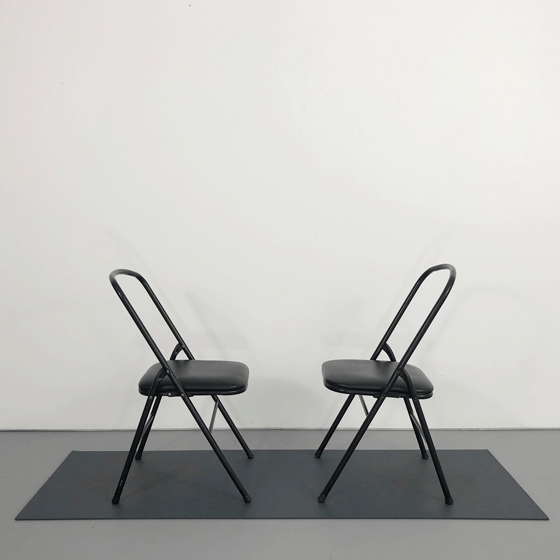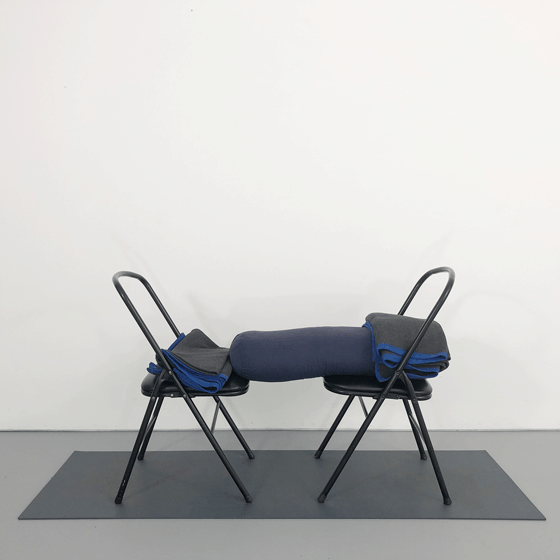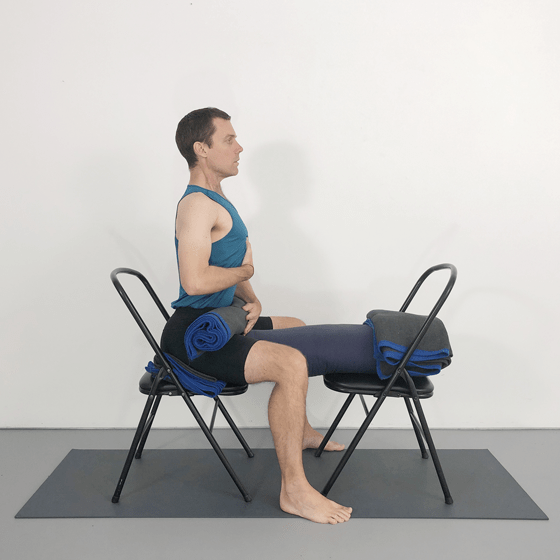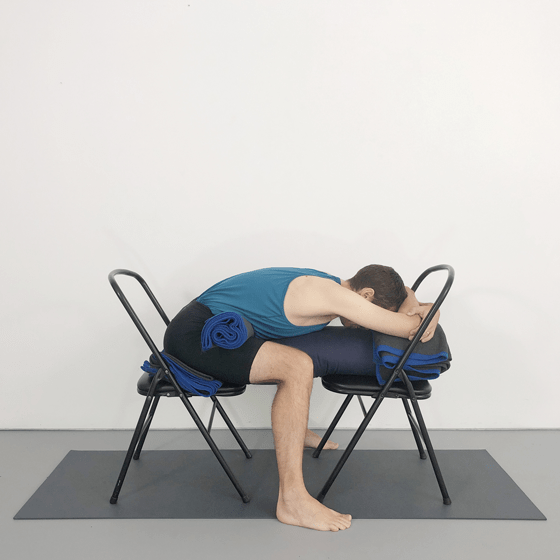There are many Iyengar yoga poses that help to relieve lower back pain. This post takes an in-depth look at a particularly soothing one: a supported version of the pose pavana muktasana. For many practitioners it is a trusted “go to” pose that can relieve aching and discomfort in the lower back.
This version of pavana muktasana might be used in an Iyengar Yoga therapy class for helping someone working with specific lower back problems. It can also be used in a yoga studio context as an alternative for poses that may be temporarily unsuitable, due to a sore lower back. Also relevant in a home yoga practice, in a more general sense, this pose can help combat minor lower back aches and pains.
Although specific yoga equipment is used in these images, this set-up can be adapted with regular chairs and improvised household items such as blankets and cushions. When correctly adjusted this pose should impart a comfortable release to the lower back. This release will be experienced as both spreading and lengthening in the lumbar region. Staying in this pose for up to 10 minutes will help to maximise its benefits.
Equipment
2 chairs, 1 bolster, 3 blankets

Position the chairs
- Place two chairs together.
- Have the fronts of the chairs facing one another.
- Leave a small gap between the chairs. The gap will be roughly 20cm or 8 inches. This space may need to be increased for taller people or decreased for shorter people.

Position the bolster and blankets
- Place a bolster over the seats of both chairs.
- Ensure that the bolster is positioned near the front edge of the chair that you will be seated on.
- Place a three fold blanket across the seat of the same chair. You will eventually sit on this blanket.
- Place a three fold blanket on the end of the bolster. When you eventually lean forwards your forehead and forearms will rest on this blanket.

Sit on the chair
- Position yourself so that you are seated on the chair blanket with your legs straddling the bolster.
- Ensure that your feet and knees are a little wider than your hips.
- Position your feet directly underneath your knees.
- Ensure that your hips are slightly higher than your knees.
- Tightly roll a blanket. Start with the blanket as you would use it for sarvangasana (shoulderstand), and roll it from long edge towards the opposite long edge.
- Place this rolled blanket firmly into the thigh crease that exists where your legs and upper torso meet. With your hands, pull the blanket back and down into this thigh crease.
- Now lift your abdominal flesh up and over the rolled blanket as you prepare to come forwards.

Lean forwards
- As you come forwards, position your abdomen onto the bolster first.
- Lengthening further forwards, place your chest down onto the bolster.
- Last of all, allow your forehead to come down and rest onto the three fold blanket.
- Manoeuvre the forehead blanket so that you are able to rest your forehead onto it without obstructing your breath.
- This blanket will also support your forearms as you now fold your arms and rest them onto the support.
Optimising the pose
- To maximise the benefit to your back, ensure that your torso is able to release in an outwards and downwards direction.
- Seen from the side your torso will more or less sit parallel to the floor. Your head and shoulders sit slightly higher than your hips.
- This alignment will assist the rolled blanket between your thighs and abdomen to simultaneously lengthen and broaden your lower back.
- Blankets may need to be added or removed from under the hips or chest to accomodate tall or short practitioners.
- A similar position can be used to help ease a headache. In the headache version of pavana muktasana the torso and head would need to be kept higher with extra supports placed under the chest. A bandage is often wrapped around the forehead and eyes in this particular version of the pose.
Conclusion
This versatile pose can be used as part of a yoga therapy sequence to specifically improve the health of your lower back. It can also be built into yoga sequences to counteract poses that tend to load the muscles in the lower back. It is also a great pose to have as part of a home yoga practice repertoire for any occasion when you are looking to relieve aches and pains in your lower back.
Learn Iyengar yoga online with expert guidance.
Stream unlimited Yoga Selection classes and build a home practice that gets results.
Try it free for 14 days. Cancel anytime.
